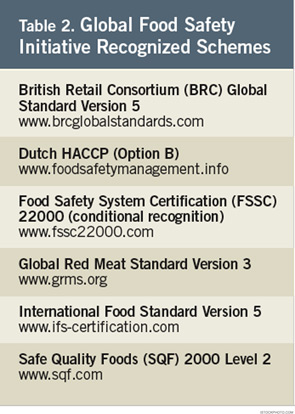Given the continued focus on the safety of our food supply, and considering recent food safety scares, a group of international retailers identified the need to enhance food safety and to ensure and strengthen customer and consumer protection. In 2000, they launched the Global Food Safety Initiative (GFSI), which sets requirements for food safety schemes through a benchmarking process to improve cost efficiency throughout the food supply chain. GFSI benchmarks existing food standards against food safety criteria and develops mechanisms for information exchange in the supply chain, consumer awareness, and review of existing good retail practices.
Through benchmarking, food safety-related schemes are compared to the GFSI Guidance Document, available at www.globalfoodsafetyinitiative.com. As a result of this process, GFSI has recognized several schemes that provide consistent results related to common requirements applied during the audit process. To date, GFSI fully recognizes five manufacturing schemes (see Table 2). Each scheme is based on the food safety standards articulated by the Codex Alimentarius Commission. Two schemes, the British Retail Consortium (BRC) and Safe Quality Foods (SQF), are gaining wide acceptance by U.S. processors, helping them to improve food safety and to retain their positions as suppliers to large retailers such as Wal-Mart.
Change Needed
Despite all the gains HACCP has made over the past several decades, more work is needed. Following recent foodborne illness outbreaks associated with peanut butter, chili peppers, spinach, lettuce, and other foods, the U.S. Congress is taking action to strengthen the FDA’s food safety responsibilities.
On July 30, 2009, the U.S. House of Representatives passed H.R. 2749, the Food Safety Enhancement Act of 2009. In Section 102, titled Hazard Analysis, Risk-Based Preventive Controls, Food Safety Plan, Finished Product Test Results from Category 1 Facilities, the act requires the Health and Human Services Secretary to “…issue guidance or promulgate regulations to establish science-based standards for conducting a hazard analysis, documenting hazards, identifying and implementing preventive controls, and documenting the implementation of the preventive controls, including verification and corrective actions under sections 418 and 418A of the Federal Food, Drug, and Cosmetic Act (as added by subsection (b)).”
Additional language is contained within H.R. 2749 that requires owners, operators, or agents of a facility to conduct a hazard analysis; identify, implement, and validate effective preventive measures; monitor preventive controls; institute corrective actions when monitoring shows that preventive controls have not been properly implemented or were ineffective; conduct verification activities; maintain records of monitoring, corrective action, and verification; and reanalyze for hazards. It also requires that owners, operators, or agents in charge of a facility develop and implement a written food safety plan before a facility introduces, or delivers for introduction, any shipment of food into commerce.
Section 5 of H.R. 2749 specifically exempts products regulated by the Secretary of Agriculture under the Federal Meat Inspection Act (FMIA)(21 U.S.C. 601 et seq.); the Poultry Products Inspection Act (PPIA)(21 U.S.C. 451 et seq.); or the Egg Products Inspection Act (EPIA)(21 U.S.C. 1031 et seq.). Additionally, it exempts livestock and poultry, USDA-regulated facilities, and farms to the extent that such farms raise animals from which food is derived that is regulated under FMIA, PPIA or EPIA.
The effective date in the act is 18 months after its enactment; implementation by small facilities is two years after enactment, and for very small facilities, three years.
In November 2009, the U.S. Senate Committee on Health, Education, Labor and Pensions approved S. 510, the FDA Food Safety Modernization Act, which changes the way FDA handles food supply safety. According to S. 510, “Not later than 18 months after the date of enactment of this Act, the Secretary of Health and Human Services … shall promulgate regulations to establish science-based minimum standards for conducting a hazard analysis, documenting hazards, implementing preventive controls, and documenting the implementation of the preventive controls under section 418 of the Federal Food, Drug, and Cosmetic Act (as added by subsection (a)).”
ACCESS THE FULL VERSION OF THIS ARTICLE
To view this article and gain unlimited access to premium content on the FQ&S website, register for your FREE account. Build your profile and create a personalized experience today! Sign up is easy!
GET STARTED
Already have an account? LOGIN

